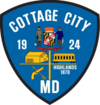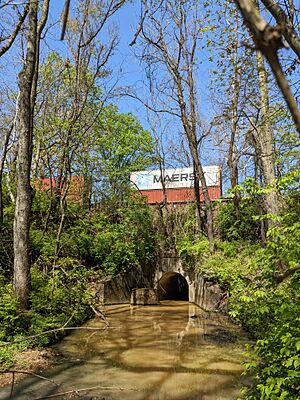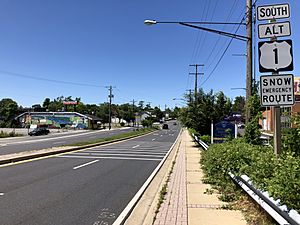Cottage City, Maryland facts for kids
Quick facts for kids
Cottage City, Maryland
|
|||||
|---|---|---|---|---|---|
| Town of Cottage City | |||||
|
|||||

Location of Cottage City, Maryland
|
|||||
| Country | |||||
| State | |||||
| County | |||||
| Incorporated | 1924 | ||||
| Area | |||||
| • Total | 0.28 sq mi (0.74 km2) | ||||
| • Land | 0.27 sq mi (0.71 km2) | ||||
| • Water | 0.01 sq mi (0.03 km2) | ||||
| Elevation | 30 ft (9 m) | ||||
| Population
(2020)
|
|||||
| • Total | 1,335 | ||||
| • Density | 4,908.09/sq mi (1,893.53/km2) | ||||
| Time zone | UTC-5 (Eastern (EST)) | ||||
| • Summer (DST) | UTC-4 (EDT) | ||||
| ZIP code |
20722
|
||||
| Area code(s) | 301, 240 | ||||
| FIPS code | 24-20050 | ||||
| GNIS feature ID | 0597284 | ||||
| Website | http://www.cottagecitymd.gov/ | ||||
Cottage City, officially known as the Town of Cottage City, is a small town in Prince George's County, Maryland, United States. According to the 2020 census, about 1,335 people live there.
Cottage City is a quiet community located near Eastern Avenue, which borders Washington. It's also close to other towns like Brentwood and Colmar Manor, and the Anacostia River. The town began in 1870 under the name "The Highlands" and officially became a town in 1924.
Contents
Discovering Cottage City's Past

The history of Cottage City goes back a long time, even before the American Revolution. Old records show that Native American tribes from the Potomac River area once lived here. When European settlers arrived, the area became known for its deep-water port on the Anacostia River, called Harrison's Landing.
A very important business there was Moyer's Grist Mill, located in a place called Yarrow. This was the first mill of its kind between Baltimore and Alexandria, Virginia. Yarrow was later renamed several times, and today it is known as Cottage City.
Battles and Famous Visitors
A historic spot called the Bladensburg Dueling Grounds was located along Dueling Creek and Bladensburg Road. This area is now shared by Cottage City and Colmar Manor. Cottage City and Moyer's Mill played a big role in the Battle of Bladensburg during the War of 1812.
Moyer's Mill was used as a hospital for wounded American soldiers and also as a place for cannons. American forces fought hard in Mr. Moyer's orchards but were defeated. This battle eventually led to the burning of the nation's capital by British forces.
After the Civil War, President Ulysses S. Grant sometimes stayed at a summer home called the Friendship House in Cottage City. This house is no longer there; an apartment building stands in its place today.
Developing a Community
In the 1870s, developers tried to create a new community called "The Highlands." They planned large lots and a grid pattern of streets. They advertised it as a place with cottages and villas on wide avenues, good views, low taxes, and close to Washington, D.C. However, this development didn't succeed at first.
In 1886, Colonel Gilbert Moyer bought the land and tried again. He divided the land into smaller lots and promoted it by saying a streetcar line would soon be built. This attempt also failed. A few houses were built starting in 1904, with wide streets and trees. A single-track trolley line ran through the community from Washington to Bladensburg, but it stopped running in 1923.
Modernizing the Town
In 1915, Charles Lightbrown tried to sell the land again, making a few small changes to the original plan. This time, it worked! Lightbrown built most of the homes in the community. These were one-story cottages with four rooms, and they were very popular with veterans returning from World War I because they were affordable and ready to live in.
Electric service came to Cottage City in 1914. In 1919, the town got water service, and sewer service was added the next year. The town officially became incorporated in 1924, taking its name, Cottage City, from the similar-looking cottages built by Charles Lightbrown.
A famous story that inspired the 1971 novel and 1973 film The Exorcist has connections to Cottage City.
Working Together for the Future
In 1999, Cottage City, along with Bladensburg and Colmar Manor, were recognized for working together on the Port Towns Revitalization Initiative. This project helped create a shared "Port Towns" identity for the towns. It also encouraged new businesses, improved roads, and helped restore historic buildings. They even rebuilt the Bladensburg waterfront and marina.
Today, Cottage City is a diverse community with old cottage-style homes on tree-lined streets. The town is actively working with the county on the Port Towns Redevelopment Plan. This plan aims to improve the neighborhoods and preserve their history, hoping to create a better environment and quality of life for everyone living there.
Where is Cottage City?
Cottage City is located at 38°56′11″N 76°57′2″W / 38.93639°N 76.95056°W.
The United States Census Bureau states that the town covers about 0.25 square miles (0.74 square kilometers) of land.
Neighboring Areas
Cottage City shares borders with:
- Washington, D.C. (to the south)
- Colmar Manor (to the southeast)
- Brentwood (to the southwest)
- North Brentwood (to the west)
- Mount Rainier (to the southwest)
Who Lives in Cottage City?
| Historical population | |||
|---|---|---|---|
| Census | Pop. | %± | |
| 1930 | 938 | — | |
| 1940 | 1,044 | 11.3% | |
| 1950 | 1,249 | 19.6% | |
| 1960 | 1,099 | −12.0% | |
| 1970 | 993 | −9.6% | |
| 1980 | 1,122 | 13.0% | |
| 1990 | 1,236 | 10.2% | |
| 2000 | 1,136 | −8.1% | |
| 2010 | 1,305 | 14.9% | |
| 2020 | 1,335 | 2.3% | |
| U.S. Decennial Census 2010 2020 |
|||
Population in 2020
In 2020, the population of Cottage City was 1,335 people. The town is home to a diverse group of residents.
- About 11.9% of the population was White (not Hispanic).
- About 34.4% was Black or African American (not Hispanic).
- About 5.2% was Asian (not Hispanic).
- About 44% of the population identified as Hispanic or Latino (of any race).
Population in 2010
In 2010, there were 1,305 people living in Cottage City. There were 467 households, with about 31% of them having children under 18.
- The average household had 2.79 people.
- The average family had 3.67 people.
- The median age in the town was 38.7 years.
- About 22.5% of residents were under 18 years old.
- About 10.4% of residents were 65 years or older.
Getting Around Town
Two main state highways serve Cottage City.
- U.S. Route 1 Alternate (also known as Bladensburg Road) runs along the border of Cottage City and Colmar Manor. It connects the town to Washington, D.C. and Bladensburg.
- Maryland Route 208 is another state highway. It connects US 1 Alternate to Brentwood via 38th Avenue.
Schools in Cottage City
Students in Cottage City attend schools in the Prince George's County Public Schools system:
- Rogers Heights Elementary School
- William Wirt Middle School
- Bladensburg High School
Famous People from Cottage City
- Elizabeth Magie: In 1904, Elizabeth Magie created a board game called "The Landlord's Game," which later became known as Monopoly. She reportedly received only $500 for her invention and little recognition for a long time.
- Ronald Hunkeler: Also known as Roland Doe or Robbie Mannheim, this person's story inspired William Peter Blatty to write the fictionalized book The Exorcist.
See also
 In Spanish: Cottage City para niños
In Spanish: Cottage City para niños






